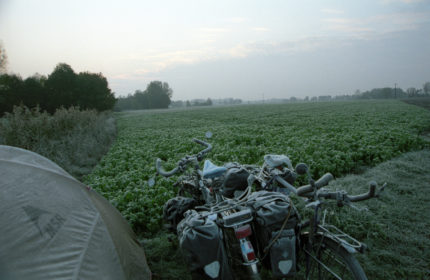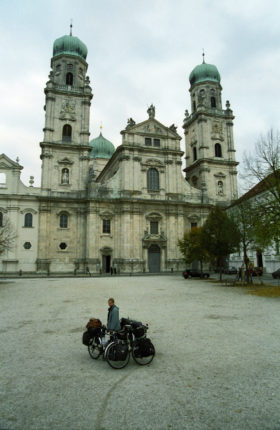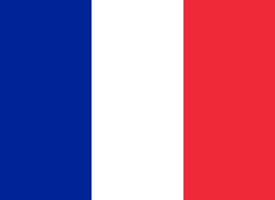
Camping in 14oF temperarure
Towards Passau
We left Munich under overcast skies and headed east towards the Austrian border. It took us three days. A strong wind was against us the first day, but the terrain was flat. We started the day on a dirt bike path in the woods bordering the Isar River. As the day progressed, we passed through brown and green fields, small towns with red rooftops and tall green church steeples dotting the horizon. Along with the neighboring state of Bade-Wurtemburg (with the Black Forest), Bavaria announces itself as Catholic with its own abundance of shrines showing Jesus on the cross. He welcomes you into every town, and lest you forget Him, He is there along the roadside, as well. Bavarians, in fact, are known to be very conservative and religious in comparison with the rest of the country. Both Bavarians and other Germans alike will tell you that Bavaria is a state apart in Germany. They all agree upon this – that there is Germany, and then there is Bavaria. They even have their own special dialect. Non-Bavarian Germans say that Bavarians have a quick temper. I haven’t yet asked a Bavarian’s opinion on this subject, though!
We awoke the following day to 14° temperatures and a white world. A thick frost covered everything from our bicycles to the ground to the tent. Icycles hung from the legs of my pants. I got up with difficulty, shivering as I piled layer upon layer. For breakfast, I had planned on my usual: yogurt, banana, and water. Forget the bananas – they were rock solid. Forget the water, as well – it had taken the shape of the inside of the water bottles and I couldn’t free even one drop. The yogurt, now – that was at least edible, but it was so cold, it gave me a headache as it was going down. Wow, only October and already this cold! Good thing we have warm sleeping bags and each other to keep warm!
It flurried off and on throughout the morning, and as we neared Passau, on the Austrian border, we passed railroads and industrial towns. About 20 kms. (12 mi.) before the town, we joined the Danube. Our first view of Passau was that of an industrial city – rather uninteresting to the visitor and not very pretty. Therefore, when we began exploring the city, we found that it had some surprises in store for us. The inner part of the town is almost completely lined in winding cobblestoned streets, many of which are pedestrian-only. Many restaurants are hidden around the corner of these twisting roads and just waiting for you to push open the door. The town is built upon a hillside and is split in half by the Inn River. In fact, the Inn and the Danube Rivers converge in Passau, and the waters of the Inn double the size of the Danube. The remainder of a stone fortress stands guard high on the hillsides.

Passau Cathedral
The special treasure that Passau had reserved for us was St. Stephen’s Cathedral. It was magnificent and splendid. The Cathedral was capped with three teal-green domes. The interior was even more beautiful. Upon entering, you found yourself in a spacious cathedral surrounded by angels and long-ago heroes. In fact, the entire ceiling was covered with thousands of angels and biblical personnages, either worshipping Christ or playing the violin, lute, or harp. The painted scenes are typically round in shape and were colored pastel green, blue, peach, and white. The walls were covered in paintings as well – some biblical, but many featuring battle scenes with horses and fallen heroes and grieving women.
To the right of the entrance was an especially beautiful prayer chapel. The light from hundreds of red prayer candles illuminated the statue of Christ and reflected the gold of the gilded gate. As you progressed deeper into the chapel,
I especially love the pipe organs, which are found in all old European cathedrals. This one (as most of them do) took up the entire back wall of the church. Just the sheer size and beauty of the instrument is always an amazement to me. I found that the cathedral was decorated quite beautifully: the craftmanship was detailled and ornate without being overdone. I found myself wondering how long it took to build such a work of art, and how many men worked upon it. I thought it must have taken ages to complete just one of the huge marble pillars.
The backside of the cathedral was like no other I’ve seen. All around the walls of the courtyard were gravestones mounted vertically. Many were rose-colored. Most of the writing was so faded that the letters were illegible. It took me a minute to even realize what it was I was looking at. Afterwards, I searched for a date to see what century they dated from. I succeeded in finding a couple in which the dates were not worn off. One was from 1507, another was from 1557. About half the gravestones were life-size. The other half were stone plaques mounted above on the walls.
The enormity and wealth of the Cathedral made us think that Passau, which is now a town of mediocre size and importance, must have once been a very important town. Probably its location on the Inn and Danube Rivers made it a crossroads for trade.
In Austria
From Passau we passed into Austria and followed the Danube towards Linz. The hills and mountains of this region called Upper Austria are filled with the changing colors of Fall. The warm golds and reds of the season seemed to warm our chilled bones. Our first full day in Austria was a Sunday, and this being the day of rest, the Austrians must have decided to stay warm at home. We had the road almost entirely to ourselve for the day. The only sound was the crackle of leaves underneath our tires. We passed sleepy little towns, the waterfront houses reflecting pale greens, blues, yellows, tans, and peaches into the river. The Danube was surprisingly still and calm, silent as the Sunday morning.
As the day wore on, we climbed steeper into the mountains, until a bike path by the Danube started and we followed the curve of the river, watching the mountains rising above. As in Germany, we saw many shrines alongside the road. We stopped to admire the deer at two deer farms. The first farm had hundreds of deer, all moving gracefully together as a herd, first in one direction and then in the other.


